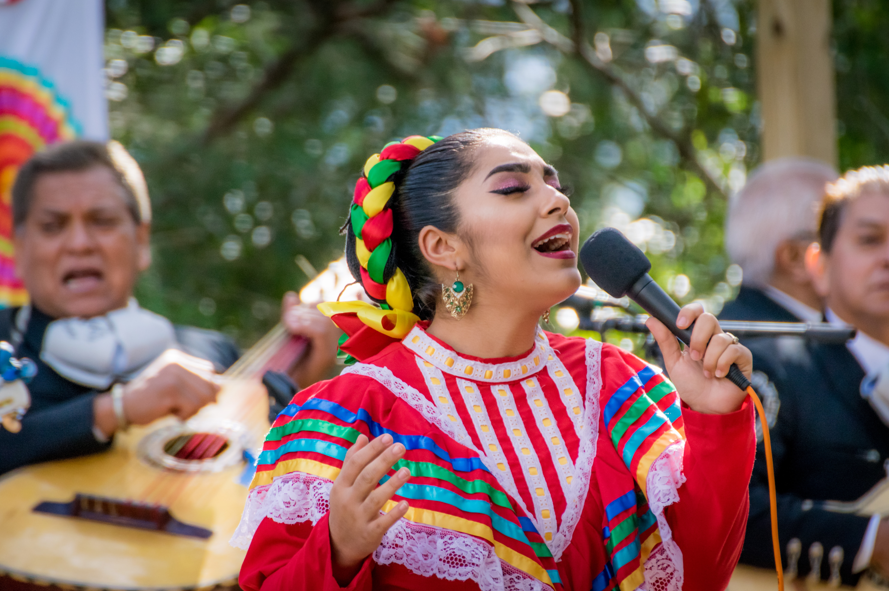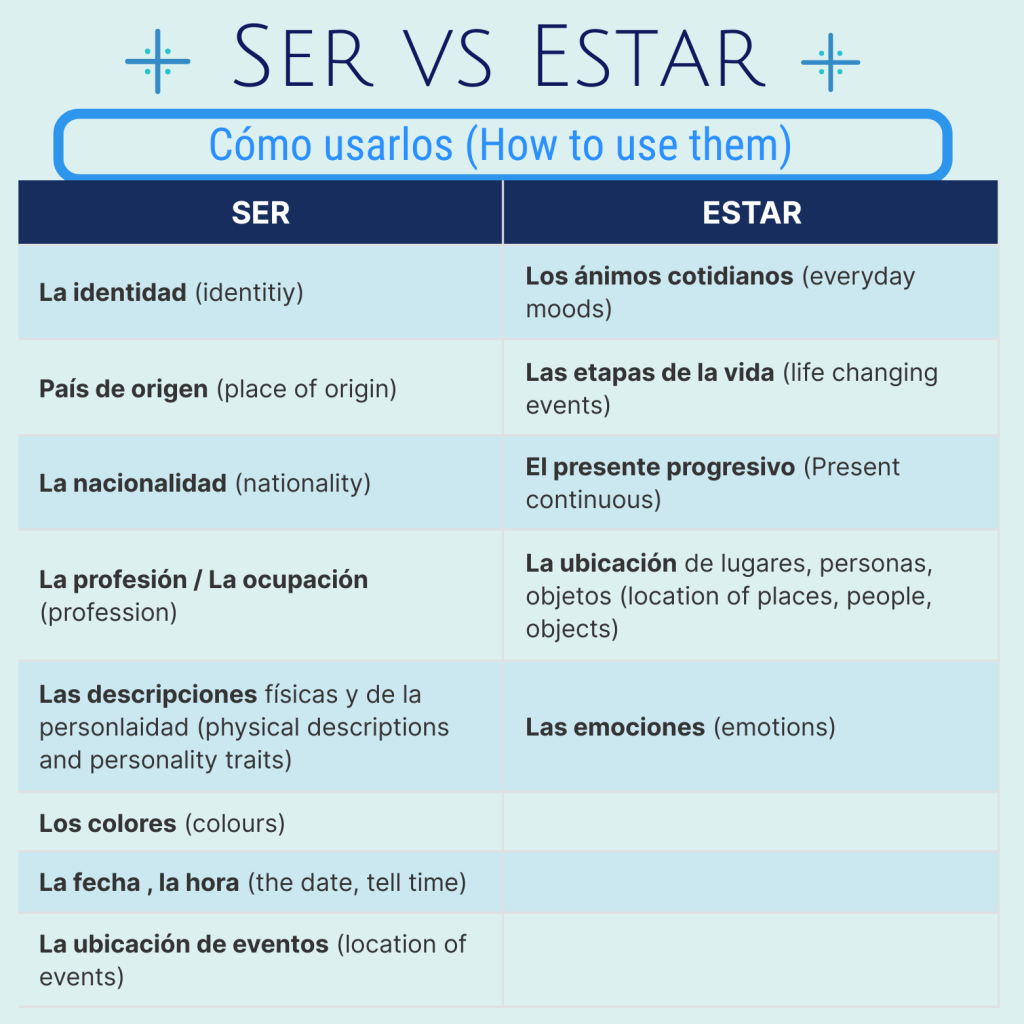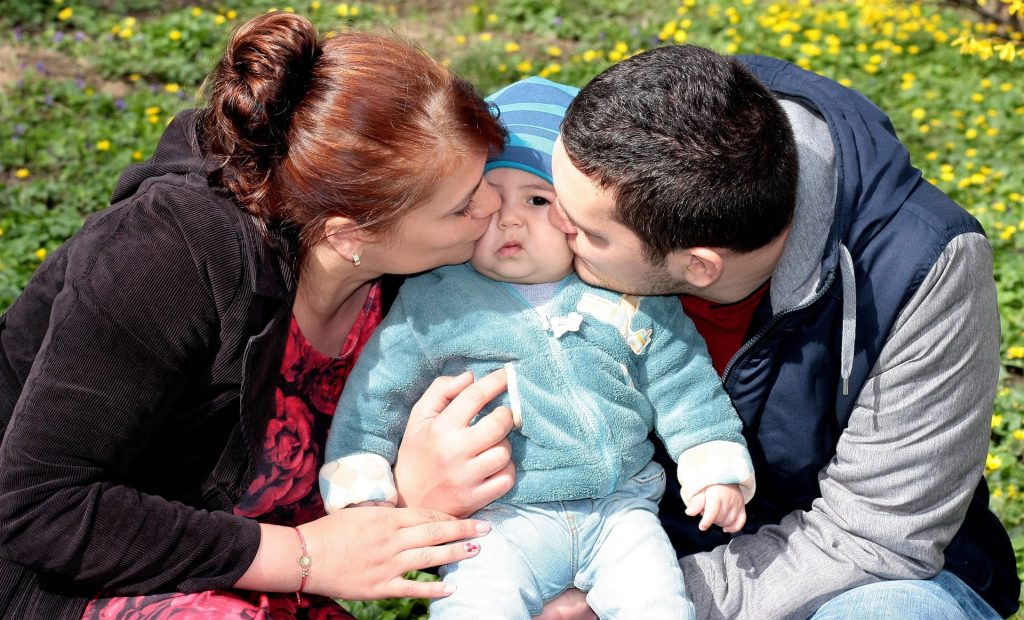Unidad 4 – Tercera Parte (Part 3)
Vocabulario
(Vocabulary)
1. Las emociones en español (Emotions in Spanish)
En la unidad 3 your learned una lista de vocabulario to describe características físicas y características de la personalidad.
You learned that los adjetivos modify a noun and that en español, los adjetivos agree with the number (plural / singular) and gender (femenino / masculino) of the noun they are describing or modifying
- La profesora de español es chilena. Ella es baja. Ella no es alta. Ella es trabajadora y muy cómica.
- Mis primos gemelos son simpáticos. Ellos no son aburridos. Ellos son muy divertidos.
Las emociones también son adjetivos and so they also agree with the number (plural / singular) and gender (femenino / masculino) of the noun they are describing or modifying.
- María está contenta (María is happy)
- Juan no está contento (Juan is not happy)
- Los estudiantes están ocupados (The students are busy)
- El primer ministro de Canadá está furioso (The Primer Minister of Canada is furious)
Haz clic on the vocabulary list of las emociones below to learn what they mean in English.
Notice that las emociónes “triste” y “feliz”[1] (sad and happpy) only agree in number of the noun they modify, but not in gender as in:
- Roberto está feliz y Susana también está feliz. Roberto y Susana están felices.
- Mi papá está triste. Mi mamá también está triste. Mis padres están tristes.
2. Los colores en español (Colours in Spanish)
Los colores can be both sustantivos y adjetivos.
Los colores como sustantivos (Colours as nouns)
Click on the vocabulary list of los colores below to learn what they mean in English when used como sustantivos:
Haz clic en el enlace de LibreText below para practicar la pronunciación de los colores y aprender más vocabulario associated with los colores:
¡A practicar!
A good way to practice los colores como sustantivos is to talk about your likes and dislikes in relation to los colores.
Lee la conversación entre Ramiro y Paola. Luego, responde a las preguntas que siguen en español in full sentences.
Ramiro: ¡Qué tal Paola! ¿Qué color te gusta?
Paola: Me encanta el azul porque es el color del mar y a mí me fascina el mar.
Ramiro: A mí no me gusta mucho el azul. Prefiero el verde porque es el color de la naturaleza y a mí me encanta tomar fotos de la naturaleza.
Paola: A mí también me gusta el verde. De hecho, mi color favorito es el verde claro porque es el color de la piedra esmeralda y yo tengo muchos anillos con la piedra esmeralda.
Copy and paste the following letters and symbols as needed.
á é í ó ú ñ Á É Í Ó Ú Ñ ¡ ! ¿ ?
- ¿Qué color le encanta a Paola? ¿Por qué?
- ¿Es el azul el color favorito de Paola?
- ¿Qué color no le interesa mucho a Ramiro?
- ¿Qué color le gusta a Ramiro? ¿Por qué?
Ahora responde la siguiente pregunta con una descripción sobre los colores que te gustan.
¿Qué colores te gustan y por qué?
Copy and paste the following letters and symbols as needed.
á é í ó ú ñ Á É Í Ó Ú Ñ ¡ ! ¿ ?
Los colores como adjetivos (Colours as adjectives)
Just like las emociones, los colores can also be adjetivos and so they also agree with the number (plural / singular) and gender (femenino / masculino) of the noun they are describing or modifying.
- Mi teléfono celular es negro (My cellphone is black)
- Mi tableta también es negra (My tablet is also black)
- Mis sandalias son rosadas (My sandals are pink)
Notice that los colores azul, gris, rosa, verde y café only agree in the number of the noun they modify, but not in gender.
- Mi computadora es gris. Mi teléfono celular es gris. Mi computadora y mi celular son grises.
- Mi casa es verde. Mi auto es verde. Mi casa y mi auto son verdes.
- El cielo es azul. El mar es azul. El cielo y el mar son azules.
¡A practicar!
Responde a las siguientes preguntas en español and in full sentences:
Copy and paste the following letters and symbols as needed.
á é í ó ú ñ Á É Í Ó Ú Ñ ¡ ! ¿ ?
- ¿De qué color (o colores) es tu animal favorito?
- ¿De qué color son tus ojos (eyes)?
- ¿De qué color es tu bolígrafo preferido?
- ¿De qué color es tu cuaderno favorito?
- ¿De qué color es tu silla favorita?
¡Más práctica!
Llena la tabla que sigue with emociones that you associate with los colores en la tabla. The first and last entries are provided to you as examples. Notice that (unless is an exception) your emotions should match your gender.
Copy and paste the following letters and symbols as needed.
á é í ó ú ñ Á É Í Ó Ú Ñ ¡ ! ¿ ?
| Los colores | |
|---|---|
| el blanco | Yo asocio el blanco con aburrido/a |
| el verde | |
| el negro | |
| el naranja | |
| el gris | |
| el rosado | |
| el morado | |
| el amarillo | |
| el rojo | Yo asocio el rojo con contento/a, con feliz |
¡A leer!
Lee y escucha el cuento : La reina de la granja
Después de leer el cuento responde a las siguientes preguntas en español and in full sentences:
Copy and paste the following letters and symbols as needed.
á é í ó ú ñ Á É Í Ó Ú Ñ ¡ ! ¿ ?
- ¿Qué animal es la reina de la granja y de qué color es?
- ¿Qué animal es enemigo de la reina de la granja y de qué color es?
- ¿De qué color es la gallina?
- ¿De qué color es la vaca?
- ¿De qué color es el pato?
Gramática
(Grammar)
1. El verbo Estar y la descripción de las emociones
(The verb Estar and description of emotions)
You already know that el verbo estar has many specific uses that differ from el verbo ser.
- Ánimos cotidianos (Everyday Moods) as in:
- Yo estoy excelente.
- El Primer Ministro de Canadá está terrible.
- Mi amiga Paulina está muy bien.
- Etapas de cambio de la vida (Life changing events) as in:
- Ubicación de lugares (Location of places) as in:
- La universidad KPU está en Surrey, está en Richmond, está en Cloverdale y está en Langley. (KPU is in Surrey, in Richmond, in Cloverdale, and in Langley)
- El parque Stanley está en el centro de Vancouver. (Stanley Park is in downtown Vancouver)
- Mi casa está en Surrey. (My house is in Surrey)
Let’s study a new use of el verbo estar:
- Descripción de las emociones (Description of emotions) as in:
- María está contenta (María is happy)
- Juan no está contento (Juan is not happy)
- Los estudiantes están ocupados (The students are busy)
- El primer ministro de Canadá está furioso (The Primer Minister of Canada is furious)
- Roberto y Susana están felices. (Roberto and Susana are happy)
- Mis padres están tristes. (My parents are sad)
As you studied en la sección de vocabulario above, las emociones también son adjetivos and so they also agree with the number (plural / singular) and gender (femenino / masculino) of the noun they are describing or modifying.
Also as studied above, las emociónes “triste” y “feliz” only agree in number of the noun they modify.
¡A practicar!
Haz clic een el enlace de LibreText below para practicar las emociones con el verbo estar en presente simple indicativo:
LibreText actividad 9.10 – Ejercicios- Estar + emociones.
Copy and paste the following letters and symbols as needed.
á é í ó ú ñ Á É Í Ó Ú Ñ ¡ ! ¿ ?
2. Resumen de los usos de los verbos Ser vs Estar
(Summary of the uses of the verbs Ser vs Estar)
La tabla que sigue resume los usos de Ser vs Estar:
¡ATENCIÓN!
As you learned en la unidad 3, the following life-changing events can also be used with ser:
- Yo estoy casada / Yo soy casada
- Yo estoy soltera / Yo soy soltera
¡A practicar!
Mira las fotografías que siguen y lee sus descripciones:




Ahora, mira la foto siguiente y escribe una descripción of what you see using as many uses of Ser and as many uses of Estar. Write en español in full sentence. The more you practice the uses of ser and estar the better equipped you will be to control their differences when talking and writing en español.
Copy and paste the following letters and symbols as needed.
á é í ó ú ñ Á É Í Ó Ú Ñ ¡ ! ¿ ?
¡Más práctica!
Completa the following sentences with the correct use of Ser or Estar in simple present tense conjugation of Ser or Estar.
Copy and paste the following letters and symbols as needed.
á é í ó ú ñ Á É Í Ó Ú Ñ ¡ ! ¿ ?
Opción Multiple (Mutiple Choice). Choose the correct answer according to the uses of Ser vs Estar.
Cultura hispanohablante
(Spanish-speaking Culture)
Expresiones de cariño en la cultura hispanohablante
(Expressions of endearment in the Spanish-speaking culture)
You already learned that las personas hispanohablantes use muchos non-verbal behaviours (NVBs) because they tend to be more emotionally expressive when interacting with others.
You also know that en la cultura hispanohablante ¡las personas son más importantes que la hora! (people are more important than time!)
Relación entre lengua y cultura (Language and culture relationship)
¿Sabías que…? (Did you know…?)
Los diminutivos (diminutives) en español are suffixes that indicate size, endearment, or contempt?
Similar to the suffix –y in English to form words like cuty and doggy, el español uses suffixes like –ito/-ita (and many other suffixes) to form words that can indicate size or endearment.
Lee the following texto that contains extracts from the Wikibooks article Spanish Diminutives:
Spanish Diminutives[2]
Diminutives are suffixes that indicate small size, youth, affection or contempt. English examples are –y in doggy or -let in the booklet.
The most common Spanish diminutive suffix is -ito/-ita. Gatito means small cat, particularly kitten. Esté quietecito is a nice way of telling someone to keep still. Unlike English, Spanish diminutives can be applied not only to nouns (gatito) but to adjectives (quietecito) and adverbs (rapidito).
Morphology of -ito/-ita
Diminutives are formed in the following ways
- replacing the last vowel by -ito/ita, or adding -ito/ita to the last consonant: perro/perrito, papel/papelito. If the word ends in the diphthongs io/ia then only one i is left: despacio/despacito.
- adding -cito/-cita: corazón/corazoncito, duende/duendecito/duendecita.
- replacing the last vowel by -ecito/-ecita, or adding -ecito/ecita to the last consonant: quieto/quietecito, pez/pececito, tren/trencito/trenecito.
- adding -cecito/-cecita: pie/piecito/piececito.
Regular formation of diminutives
- Words ending in unstressed o/a or diphthongs io/ia replace it with -ito/-ita:gata/gatita, Julio/Julito, vacío/vaciíto, feo/feíto.
- Words ending in unstressed e/i/u or stressed vowel add -cito/-cita: duende/duendecito/duendecita, whisky/whiskicito, sofá/sofacito.
- Words ending in n or r add -cito/-cita: camión/camioncito, motor/motorcito.
- Words ending in another consonant add -ito/-ita: farol/farolito, lápiz/lapicito.
- The diminutive is formed from the masculine and/or singular form. Patrón->patroncito/patroncita.
It follows that all diminutives ending in -ecito/-ecita are irregular.
Some irregular diminutives: novio/noviecito, pez/pececito, Carlos/Carlitos, mano/manito/manita (manita is used in México and Spain), caliente/calentito.
Diminutives of diminutives
chico/chiquito/chiquitito; poco/poquito/poquitito.
-ico/-ica
In some countries, particularly Colombia and Cuba the endings tito/tita are replaced by tico/tica, zapato/zapatico (preferred to zapatito). Other examples: pato/patico, rato/ratico.
Other diminutive suffixes
- -illo/-illa: venado/venadillo, mujer/mujercilla. (Affectionate, pejorative.)
- -ico/-ica: perrico/perrica
- -ucho/-ucha: casa/casucha. (Pejorative.)
- -ín/ina: pequeñín/pequeñina. (Affectionate.)
- -uelo/uela: ladrón/ladronzuelo/ladronzuela. (Affectionate.)
- -ete/-eta: viejo/vejete. (Pejorative.)
- -uco/-uca: perro/perruco. (Pejorative. Used mainly in Cantabria.)
Ahora mira los 2 videos que siguen to grasp more examples on how to form diminutives and how they are used:
¡A practicar!
Based on the information you learned above try to come up with los diminutivos of the following words (the first entry is given to you as an example):
| Palabra | Diminutivo |
|---|---|
| ahora | ahorita |
| amor | |
| papá | |
| casa | |
| café | |
| gato | |
| abuela | |
| mamá | |
| hermano | |
| flor |
En mi opinión…
Does your language or any languages you speak form diminutives? If so, provide examples. How do they compare to los diminutivos en español? Reflect in English.
When Spanish speakers use los diminutivos is because they have an intention: be polite, be affectionate, be sarcastic, etc. Can you think of any reason why you would use diminutives within your language or languages your speak? How do they compare to the uses of los diminutivos en español? Reflect in English.
Media Attributions
- Usos de Ser vs Estar © Constanza Rojas-Primus is licensed under a CC BY-NC (Attribution NonCommercial) license
- Work and Sleep © Bruno Emmanuelle is licensed under a Public Domain license
- Paciente en el hospital © Mufid Majnun is licensed under a Public Domain license
- Tough times © Ben White is licensed under a Public Domain license
- Mujer cantando © Barth Bailey is licensed under a Public Domain license
- Mujer lanvando ropa en el río. © Esteban Benites is licensed under a Public Domain license
- Expresión de cariño © pxfuel.com is licensed under a Public Domain license
- Friends © Omar Lopez is licensed under a Public Domain license
- Feliz and contento(a) are synonyms in Spanish. ↵
- Spanish Diminutives by Wikibooks® is licensed under the Creative Commons Attribution-Share Alike License 3.0 ↵
adjectives
for example
identical twins for males or mix gender
also
click on
nouns
as, like
link
pronunciation
to learn
let´s practice!
read (as a command)
conversation
between
then
answer
that follow
because
sea
nature
in fact
emerald stone
rings
why?
now
with
about
why?
blue
grey
pink
green
brown as colour / coffee as a hot drink
sky
more practice!
fill out
emotions
colours
let´s read!
to listen (as a command)
tale, story
after
to be
to be
An adjective meaning "alive" for a woman.
an adjective meaning "dead" for a woman.
an adjective meaning "married" for a woman.
an adjective meaning "single" for a woman.
what follows, below
summarize, sum up
attention!
look at, watch
following
write (as a command)
complete, to fill out
a lot, plural
text
in my opinion





